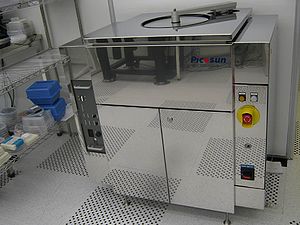Specific Process Knowledge/Characterization/SEM LEO
THIS PAGE IS UNDER CONSTRUCTION
SEM LEO
Feedback to this page: click here
ALD - Atomic layer deposition

The Picosun R200 ALD (atomic layer deposition) tool is used to deposit a very thin layer of Al2O3,TiO2 or Pt (not testet yet) on different samples.
Each process is using two different precurcors. The reaction takes place in cycles. During each cycle a very short pulse of each precursor is introduced into the ALD reaction chamber in turns, and in-between each precursor pulse the chamber is purged with nitrogen. All reactions have to take place on the sample surface, thus it is very important that each precurcor is removed from the chamber before the next one is introduced. In that way the ALD layer will be deposited atomic layer by atomic layer.
In order to ensure that the ALD reactor has the same temperature eveywhere, it has a dual chamber structure. The inner chamber is the ALD reactor with the sample holder, and the outer chamber is a vacuum chamber that is isolating the reactor from room air. The space between the two chambers is called an intermediate space (IMS). The IMS is connected to a nitrogen carrier gas line.
When the reactor chamber is heated up or cooled down, it will take some time before the sample holder and the sample reach the desired temperature. Thus, it is important to include a temperature stabilization time in the process recipes.
The ALD deposition takes place in the reactor chamber. All precursor and nitrogen carrier gas lines are connected to the reactor chamber through separate gas lines. The percursors pulse time is controlled using special ALD valves, that allow very short precursors pulses to be introduced into the ALD reactor and a at the same time allow a constant nitrogen purge.
The ALD reaction takes place under vacuum, thus a vacuum pump is connected to the bottom of the ALD reactor. The pump is located in the basement.
The liquid precursors (TMA, TiCl4, MeCpPtMe3 and H2O) are located in the cabinet below the ALD chamber. When these precursors are not in use, the manual valves have to be closed. Ozone is generated by use of an ozone generator that is located on the side of the machine.
It is possible to change the sample holder, so that ALD deposition can take place on different samples, e.g. a small wafer batch or a number of smaller samples. Samples are loaded manually into the sample holder by use of a tweezer.
A short presentation with some information about the ALD tool can be found here.
The user manual, the user APV and contact information can be found in LabManager:
ALD Picosun R200 info page in LabManager,
Process information
- Standard recipes on the ALD tool
- Results from the ALD acceptance test
- Al2O3 deposition using ALD
- TiO2 deposition using ALD
| Equipment | ALD Picosun R200 | |
|---|---|---|
| Purpose | ALD (atomic layer deposition) of |
Please note that it might not be possible to deposit all marials at the same time |
| Performance | Deposition rates |
|
| Thickness |
| |
| Process parameter range | Temperature |
|
| Precursors |
Please note that not all precursors might be mounted on the tool at the same time | |
| Substrates | Batch size |
|
| Allowed materials |
| |
